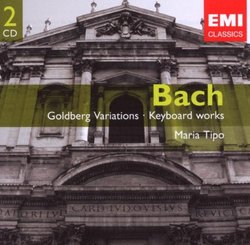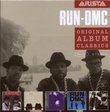A Tremendous Reading of the Goldberg Variations
Snow Leopard | Urbana, IL | 10/23/2007
(5 out of 5 stars)
"Tipo is a wonderfully accomplished, and very intelligent, reader and performer of Bach, which makes this 2-CD set of her selected Bach recordings quite economical. Even so, this review is dedicated primarily to the recording of the Goldberg Variations included in this set, not only because Tipo's reading is so impressive, but also because this is one of the few places where the recording is available.
It must be noted that the remastering claimed of this disc does not result in audiophile-quality sound at all. In fact, a slightly more expensive ($22) 5-disc set is also available, which includes the Goldberg Variations along with considerably more music, and pretty much the same sound quality. There is also an import disc, not directly available from Amazon, which starts at $20.00--less music, more money = not such a good deal. If it seems like one must choose between quantity (the 5-CD set) or quality (the 2-CD set), in this particular case, quantity seems to have the edge.
As for the performance of the Goldberg Variations itself, Tipo plays with insight, charm, energy and above all a cunning musical intelligence. One of the particular joys of the Goldberg Variations is hearing different performers mine out new or different contrapuntal gestures from the music. In Variation 1, for instance, she pops out notes with simply infectious appeal, while in Variation 25, she opts to play more slowly than is typical, and with a very silky legato, which allows her to ring out different calls and responses in the music not previously so clearly emphasized.
For listeners who are new to the Goldberg Variations, there are of course many details that one will not note so clearly, compared to someone who has listened to the variations many times in many different recordings. What you will hear with this recording is a sure pianistic intelligence that is not simply working its way through the pieces. Bach, perhaps more than any other now world-famous composer, interpretively demands more of his performers, and Tipo rises to the challenge ably. Putting this another way, making musical sense of the music takes more work.
In the opening Aria, for instance, the experienced ear notes that Tipo elects to play the rhythm from the 8th to the 9th note slightly more "straight through" than other performers (and almost identically to Perahia's recording). This will seem like an overly precious attention to detail (perhaps) both on the part of Tipo and this reviewer, but these are the kinds of differences one notes from performer to performer. For newcomers to the piece, however, what may be noticeable is how orchestral the Aria sounds, despite its apparent simplicity, and especially the many and brilliantly placed single accent notes in the left hand. Again, this may sound like over-sensitivity to the music, but the Aria features some of the most perfectly placed notes in a composition ever, and when the performer gets them right, as Tipo does, the cumulative effect is felt in the music, even when an "untrained ear" is listening for it. Similarly, Tipo's decisions to play the repeats in each piece or not contributes to how each piece "feels".
Since there are 30 variations, it is not feasible to comment on them all. For those who think of variations as being (often repetitious) variations on a theme, in fact Bach does not compose variations on the opening, but instead uses a bass line and the chord progression as the foundation for each variation. As such, this work covers more territory than most theme and variations, and features several pieces (particularly the minor ones) that seem wholly unrelated to the cycle as a whole, but nevertheless provide important contrasts.
One has to say that one of the most continuously satisfying elements of Tipo's performance is the crispness and snap of her playing. The word "grace" has been applied to her play as well, but this grace should not be understood only in a flowing sense (which Tipo displays just as nicely in, say, Variation 9, but also in the sheer dexterity and precision of grace as well). In Variation 5 in particular, Tipo provides one those exquisite Goldberg Variation joys, when she rings out the highest of note in the right hand with such brilliant clarity that it sounds like a sculptor's hammer crisply striking a chisel. It's amazingly crisp and (viscerally speaking) simply yummy and fun. In fact, throughout the whole variation the "pop" of the right hand is exceptionally fetching, and capped by that brilliant note twice.
Tipo's reading, while always insightful, is not always ideal. In Variation 3, her heavily accented chords in the right hand with the slinkily creeping left hand seem out of step with one another. While certainly a feat of technique, it leaves something to be desired for the ear. Even in its slight mis-step, however, the Variation serves as a nice set up to the marvelously staccato and bouncy variation to follow, and even more so for the notoriously warp-speed scales of Variation 5.
Throughout the recording, Tipo displays a willingness to take chances. With Variation 11, she elects for an almost blurry smoothness of playing that shades the voices together; whether ingeniously or poorly will be a matter of taste. Similarly, in Variation 14, which she launches into with an abandon rarely heard, the music spirals out nearly to the point of flying to pieces, even sounding off-rhythm a bit at the end; a bit of (perhaps inadvertent) slushiness that actually sets up the variation to follow again rather nicely. The "audacity" of the moment, in any case, seems forgivable in the larger context of the recording.
Some consider Variation 16, the "French overture" to be another key interpretative moment, as the midpoint of the Goldberg cycle. From the beginning, Tipo establishes an appropriately orchestral feel to the music, and then varies the tempo and dynamics, becoming slower and softer as the first repeat is approached, making the overture almost introspective for a moment (something overtures, as fanfares, are hardly known for). Variation 17 is even more striking, since she raises the right hand an octave higher than Bach wrote; a move that brings out the skittering lightness of the variation all the more. I'm not sure if this puts the music beyond the range of what was available to Bach (and harpsichords) at the time of composition, but it's intriguing to ponder what Bach might have thought of his variation in this guise, since Tipo does such good service to it. In Variation 20, which is a breathlessly fast piece popping again with Tipo's accents, her contribution to the piece is to hold the very last note much longer than usual, which gives an effect to the piece one really must hear to appreciate. In Variation 21, she plays the phrasing with a gentle, oceanic rising and falling that both provides a canny interpretation of the piece, and also makes her performance stand out from others.
In Variation 22, Tipo once again expands Bach's music, playing the left hand an octave lower (if not also playing octaves themselves). Whatever objections one might wish to make to this, it is certainly the case that the gorgeous resonance of the piano, and the grandeur of the larger left-hand accompaniment really brings out a new character in this variation, and sets up (again) the skittery, high-register scales and trills of the variation to follow. With Variation 25, the aching "Black Pearl" variation, Tipo mines it out to 7'10" without becoming maudlin or overly sentimental. With Variation 27, she deploys perhaps her most "extreme" reading, by very widely varying the dynamics (something, again, which Bach could not do on harpsichord). The super sharp accents that end the piece drive the contrast all the more home. It is clear at this point that Tipo is not simply playing these pieces on piano, but reinterpreting them through the new resources that the piano provides. Of course, other performers exploit the piano when they play on it but, for example, shifting Bach's musical voices into octaves not previously available is something if not unique to Tipo's work, then particularly emblematic of her approach to this recording. One hears it again in Variation 29, which has more grandeur than usual, and is reminiscent of the intense sonority that Tureck's famous (or infamous) harpsichord could muster when playing Bach.
Overall, this is very much a recording by an artist quite literally engaging the music, even to the point of modifying it to make it more itself, as it were. Be forewarned about the sound-quality, however, especially in the reprise of the aria. Nevertheless, the performances here are so engaging that they usually seem to overcome any distraction by the sound most of the time. Stated more briefly, of the many Goldberg recordings I own, this one gets listened to a lot, even when the sound quality intrudes.
It's quite surprising to me that no one has reviewed any of Tipo's Goldbergs yet, because this is definitely a disc to add alongside the other monumental recordings of this work. Highly recommended."


 Track Listings (32) - Disc #1
Track Listings (32) - Disc #1
